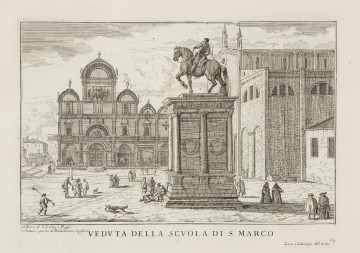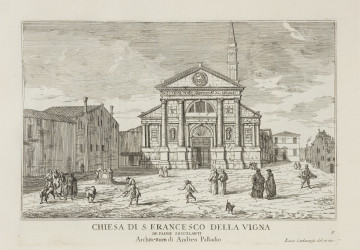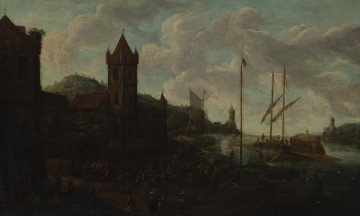
Vedvta della Scuola di S. Marco | View of Scuola di S. Marco
1768
National Museum in Szczecin
Part of the collection: Italian graphics
A view of the ancient Arch of Septimius Severus (145/146-211), was presented by Giovanni Battista Piranesi (1720-1778) in a perspective close-up, facing the Capitoline Hill towards the Forum Romanum. A street built up with tall, modern houses runs in the background. The ruins prominent on the right are the fourth-century temple of Saturn, and the lone column on the left is probably the Column of Phocas, built in honour of the emperor of the Eastern Empire in 608. The arch is decorated with bas-reliefs depicting the victorious procession of Septimius Severus. Its lower part has been buried by layers of soil accumulated from land erosion above, as well as rubbish that has accumulated over the centuries. In the neglected area around the monument, paupers from Rome gather, presumably waiting for a donation from tourists. The monument, according to the inscription on the beams, commemorated two victories over the Parthians by Septimius Severus and his sons Marcus Aurelius Antoninus called Caracalla (188-217) and Geta (189-212). Constructed of white marble in 203 triumphal arch was built near the base of the Capitoline Hill, east of the relics of the temple of Jupiter, and consecrated in 206. It was erected in honour of Caesar Septimius Severus and his descendants gained through war victories. The Veduta dell'Arco di Settimio Severo engraving was first featured in the work of G.P. Piranesi's Vedute di Roma in 1772. The present engraving, on the other hand, was published in 1783 or later. Piranesi was active in Naples and Venice, yet predominantly in Rome, where he initially worked as an agent and dealer of engravings by Joseph Wagner (1706-1780), before setting up his own engraving studio in Via del Corso. He was interested in antiquity and archaeological research himself, as demonstrated by the title of honorary member of the Royal Society of Antiquarians in London, which he received in 1757. In 1761, once he was an established artist, the Academy of St. Luke in Rome also welcomed him into its honourable circle, and in 1767 Pope Clement XIII granted him a knighthood. Ewa Gwiazdowska
Author / creator
Object type
etching (print)
Technique
etching
Material
watermarked ribber laid paper
Origin / acquisition method
purchase
Creation time / dating
Creation / finding place
Owner
Muzeum Narodowe w Szczecinie
Identification number
Location / status

1768
National Museum in Szczecin

1768
National Museum in Szczecin

1680 — 1700
National Museum in Szczecin
DISCOVER this TOPIC
Castle Museum in Łańcut
DISCOVER this PATH
Educational path